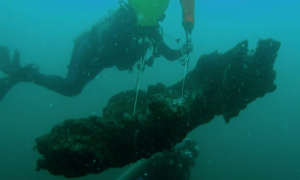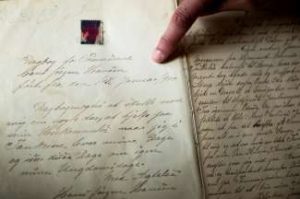Growing up, Crystal Worl remembers looking up at the 120-foot-long mural on G Street that showed major events in Anchorage’s history: the Alaska Purchase, a Fur Rondy auction, a series of World War II planes.
For years, the wall of the RIM Architecture building behind City Hall featured the Anchorage History Mural, which was painted in 1995 by artist Bob Patterson.
But Worl said there wasn’t anyone in the painting who looked like her. She didn’t see many Alaska Native faces, or women.
“I felt that it was very lacking of being inclusive of Indigenous people, and I felt that the only acknowledgement it gave me was that I exist in the past and that my history is not present,” she said in a recent phone interview.
Nearly 30 years after the original mural was created, Worl is now taking a paintbrush to the same wall and designing her own. The art, she said, is a way to tell a different version of the city’s history — a story that celebrates the diverse Alaska Native people who make Anchorage their home.
‘It’s not like a marble sculpture’
A number of new murals have been installed downtown during recent years as part of the Alaska Mural Project, which was formed by the Anchorage Museum in 2020 to improve the community through public art.
The murals are an opportunity for Anchorage to update public art with new narratives and ideas about the city while giving the downtown area a makeover, said James Temte, Alaska Pacific University’s project manager.
Murals are not intended to last forever, said Temte, who’s also a muralist.
“It’s not like a marble sculpture or anything, and so I think murals, they come and they go, and this is just the next of a new series,” he said. “With street art, mural art, it’s very much a progress — it’s not stuck in time.”
:quality(70)/cloudfront-us-east-1.images.arcpublishing.com/adn/OPOATTX4GVFEFOG2NLAOL3HWRE.JPG)
:quality(70)/cloudfront-us-east-1.images.arcpublishing.com/adn/INRDJ2PGD5HSTPNQVLYP4AIANQ.JPG)
Worl applied to be part of the mural project more than two years ago and was selected by a panel of community leaders from the Anchorage Museum, Alaska Pacific University, Anchorage Downtown Partnership and others.
Worl, who is Tlingit, Athabaskan, Yup’ik and Filipino, said she was eager to bring Indigenous culture into everyday life for people in Anchorage. She recently finished a mural on civil rights activist Elizabeth Peratrovich in Juneau.
Museum officials reached out to the co-owners of the RIM Architecture building, Barbara and Larry Cash, about participating in the mural project.
The building has a large, exposed wall that is a perfect for a mural, Barbara Cash said.
“It’s about recognizing and celebrating the sense of place and the local identity. … We thought it was a refreshing, forward-thinking movement that they had put together and we were very excited to participate,” she said.
Murals and public art are an accessible way for visitors to learn about Anchorage on a deeper level, Cash said.
“I think the relevance of going back to recognize and celebrate the original owners and stewards of the land, it very much emphasizes our unique identity here,” she said. “When people come to visit Alaska, and when they live here, hopefully the visitors get to feel more and more the roots of the place rather than just what stores are open. I think that’s very meaningful.”
Making space for an overlooked history
Crews covered the prior mural with white paint last week, and Worl began working this week on the new mural. She said she expects to finish in a few weeks, weather permitting.
The sight of the old mural getting painted over was met with some criticism on social media.
Worl said she knows some are upset the former mural is being replaced, but she feels it’s the right time for change given the cultural shift in Anchorage and around the country to recognize people of color in historical accounts.
“When I started doing public art, I was in lockdown during COVID, almost three years ago, and the Black Lives Matter movement happened and George Floyd happened and it was a whole chain of events that led to the removal of colonial statues,” she said. “And I saw that as opportunity, as space being made for people of color to step up and make art in place of those old pieces. And so it’s scary, but it’s exciting.”
[Anchorage residents mourn as demolition begins on historic 4th Avenue Theatre]
:quality(70)/cloudfront-us-east-1.images.arcpublishing.com/adn/L35PTXO5ANB75PH4IC2P6ZSXOE.jpg)
In the old mural, the highlights of Anchorage history largely began after 1778, when Captain James Cook arrived. But Alaska Natives have been in the area for thousands of years and their history is often overlooked, Worl said.
Her mural depicts human figures, animals and nature in the Chugach Mountains. Worl said she plans to incorporate Alaska Native tribes within the small details of the mural, such as beading texture in much of the landscape, including depictions of dentalium jewelry, an important part of Dena’ina culture. And Worl is incorporating formline design, a type of art associated with Tlingit, Haida and Tsimshian tribes.
Worl said she is painting with vibrant colors as an homage to how innovative her ancestors were.
“They adapted to change,” she said. “They took on new tools and new pigments and new items that helped them ever evolve and create new work, so I’m really embracing that mentality in this project by bringing in new color palettes, new textures, new tools and methods to achieve the piece.”
:quality(70)/cloudfront-us-east-1.images.arcpublishing.com/adn/V76OERLGF5G4DFVPSUFKA34UME.JPG)
:quality(70)/cloudfront-us-east-1.images.arcpublishing.com/adn/3BSWMGU4Q5HULGHJ2OM7STYRXU.JPG)
On Wednesday afternoon, Worl stood on a blue mechanical lift, high above the pavement, as she added swaths of purple to the mural just starting to take shape. Tourists milled about outside the Dena’ina Center across the street and locals stopped to pause at the new art.
Kat Barron and Oscar Avellaneda-Cruz specifically walked on G Street to see the mural after they took a break from work to buy ice cream on the sunny afternoon. Avellaneda-Cruz knows Worl, but said he is especially excited about the mural because he sees it as the community taking a step toward inclusivity.
“For a long time, a lot of the institutions that made or designed the city didn’t look at what the actual community or commons cared about,” he said. “And the board of the Anchorage Museum even listening is a good sign of the passing of the guard.”
Barron said the art made her feel hopeful. She wants a more inclusive community where everyone feels welcome.
That’s always been Worl’s goal.
“It’s a little bit rough and rugged when you can’t please everyone, but at the same time, this is who I am and this is what I’m doing,” she said. “There’s going to be some young person who looks up at that mural and is going to start growing up looking and connecting to that mural. And I want them to feel included.”
• • •




